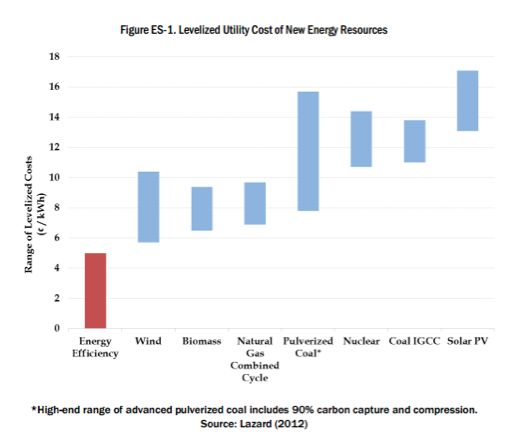It's not that surprising that energy efficiency initiatives reduce customer demand for electricity. But it may come as news to some that energy efficiency appears to decrease the cost of the energy that is used.
That’s one interesting conclusion of a new report from the American Council for an Energy Efficient Economy looking at implementation of an energy efficiency resource standard (EERS) in Ohio. The paper finds that the EERS is lowering wholesale energy prices and wholesale capacity prices in the state. This will save Ohioans a total of $5.6 billion between now and 2020, with every dollar spent on efficiency saving more than $4 over the life of a project or technology.
The vast majority of that, $3.37 billion, comes from lower electricity bills. However, at least $1.3 billion in savings comes from lower wholesale capacity prices and $880 million comes directly from lower wholesale electricity prices. Once the revenues utilities receive from selling energy efficiency resources are factored in, the net savings are about $2.7 billion.
Energy Efficiency Lowers Wholesale and Capacity Prices
Electricity prices are driven by factors including fuel cost, transmission congestion, public policy, and load. While these variables are weighted differently based on their impact on prices, load is generally the most determinative factor. This is the lever that energy efficiency pulls; by reducing load, wholesale prices are lower across the board.
Small changes in load dramatically change the market dynamics for all competitive resources, particularly at the margin. This is because lower peak demand means some peaker plants will not come on-line, altering prices across the board since these resources are considerably more expensive and set the clearing price for all other generation.
The report heavily caveats the authors' analysis, since the impact of load reductions on prices is “not linear or average.” However, it concludes that the estimate of $880 million in price savings for consumers is probably on the conservative side.
The impact of efficiency on capacity markets is also significant. Capacity markets schedule resources years in advance, and compensate those resources for their availability. This ensures well ahead of time that the grid can maintain enough generation to provide electricity during peak hours of the year, as well as the buffer of an additional 15 percent in case of emergencies. Capacity markets serve a very important role in reliability, since building new capacity takes years, and spot electricity markets don’t always provide long-term signals about the viability of resources.
Fundamentally, the clearing price for the capacity market is set by the bid of the last marginal unit needed to meet demand. Energy efficiency can be bid into the market as capacity, since reducing load by 600 megawatts is the equivalent of building 600 megawatts of capacity to meet that demand, if efficiency efforts aren’t undertaken. In simpler language, forgoing the use of a particular amount of electricity is treated the same as providing that same amount of electricity.
As with the spot markets, this reduces the utilization of marginally more expensive capacity resources in favor of implementing efficiency measures. The report finds that bidding just 75 percent of reductions into the Ohio market would have reduced wholesale prices by 21 percent for a total of $1.3 billion in savings out to 2020.
It is important to remember, though, that savings from efficiency are not free. Although it is a demand-side resource like demand response, efficiency technology requires higher capital investments that offset the savings from these programs. However, when compared to other capacity investments, efficiency is still easily the most cost-effective resource to meet demand.

The chart above shows that the average cost of efficiency measures is about 3 cents per kilowatt-hour -- or about half the cost of the low-end estimates for wind, biomass, and combined-cycle natural gas.
Generation is necessary, since homes cannot be powered with efficiency. However, there are compelling economics for increasing efficiency measures to reduce load as opposed to building new capacity to meet demand. First, the data shows that the United States has a large amount of excess capacity already in the system, and that it could significantly increase the utilization of the existing fleet of generation resources. Second, the economy as a whole is still incredibly inefficient overall today, meaning there is a lot of headroom for big efficiency gains.
Since ratepayers ultimately foot the bill for whatever investments get made, these variables matter. Will utilities make low-cost investments in efficiency, or continue to build expensive new capacity that is underutilized? The Ohio energy efficiency resource standard is a good example of a state taking the long view on their electricity markets, and beginning to craft incentives and regulations to encourage smart, low-carbon investments by utilities.
***
Adam James is a Research Assistant for Energy Policy at the Center for American Progress and the Executive Director of the Clean Energy Leadership Institute. You can email him at [email protected] and follow him on Twitter @adam_s_james.



